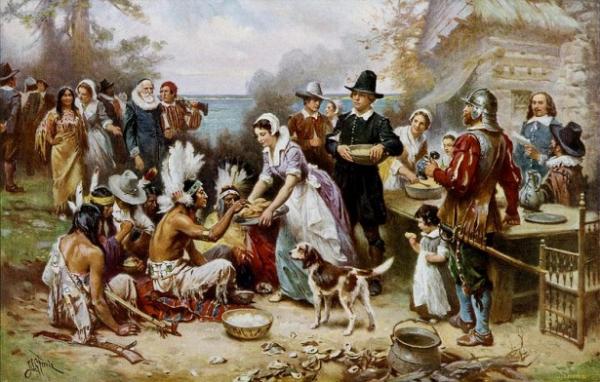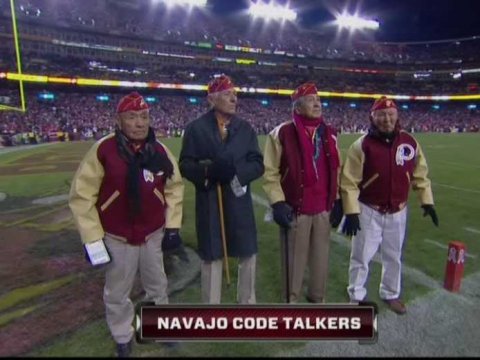Support your local Native artists next Saturday (November 30th) at the Daybreak Star Art Mart.
Month: November 2013
What Really Happened at the First Thanksgiving? The Wampanoag Side of the Tale

By Gale Courey Toensing, ICTMN
When you hear about the Pilgrims and “the Indians” harmoniously sharing the “first Thanksgiving” meal in 1621, the Indians referred to so generically are the ancestors of the contemporary members of the Wampanoag Nation. As the story commonly goes, the Pilgrims who sailed from England on the Mayflower and landed at what became Plymouth, Massachusetts, in 1620 had a good harvest the next year. So Plymouth Gov. William Bradford organized a feast to celebrate the harvest and invited a group of “Native American allies, including the Wampanoag chief Massasoit” to the party. The feast lasted three days and, according to chronicler Edward Winslow, Bradford send four men on a “fowling mission” to prepare for the feast and the Wampanoag guests brought five deer to the party. And ever since then, the story goes, Americans have celebrated Thanksgiving on the third Thursday of November. Not exactly, Ramona Peters, the Mashpee Wampanoag Tribe’s Tribal Historic Preservation Officer told Indian Country Today Media Network in a conversation on the day before Thanksgiving 2012—391 years since that mythological “first Thanksgiving.”
We know what we’re taught in mainstream media and in schools is made up. What’s the Wampanoag version of what happened?
Yeah, it was made up. It was Abraham Lincoln who used the theme of Pilgrims and Indians eating happily together. He was trying to calm things down during the Civil War when people were divided. It was like a nice unity story.
So it was a political thing?
Yes, it was public relations. It’s kind of genius, in a way, to get people to sit down and eat dinner together. Families were divided during the Civil War.
So what really happened?
We made a treaty. The leader of our nation at the time—Yellow Feather Oasmeequin [Massasoit] made a treaty with (John) Carver [the first governor of the colony]. They elected an official while they were still on the boat. They had their charter. They were still under the jurisdiction of the king [of England]—at least that’s what they told us. So they couldn’t make a treaty for a boatload of people so they made a treaty between two nations—England and the Wampanoag Nation.
What did the treaty say?
It basically said we’d let them be there and we would protect them against any enemies and they would protect us from any of ours. [The 2011 Native American copy coin commemorates the 1621 treaty between the Wampanoag tribe and the Pilgrims of Plymouth colony.] It was basically an I’ll watch your back, you watch mine’ agreement. Later on we collaborated on jurisdictions and creating a system so that we could live together.
What’s the Mashpee version of the 1621 meal?
You’ve probably heard the story of how Squanto assisted in their planting of corn? So this was their first successful harvest and they were celebrating that harvest and planning a day of their own thanksgiving. And it’s kind of like what some of the Arab nations do when they celebrate by shooting guns in the air. So this is what was going on over there at Plymouth. They were shooting guns and canons as a celebration, which alerted us because we didn’t know who they were shooting at. So Massasoit gathered up some 90 warriors and showed up at Plymouth prepared to engage, if that was what was happening, if they were taking any of our people. They didn’t know. It was a fact-finding mission.
When they arrived it was explained through a translator that they were celebrating the harvest, so we decided to stay and make sure that was true, because we’d seen in the other landings—[Captain John] Smith, even the Vikings had been here—so we wanted to make sure so we decided to camp nearby for a few days. During those few days, the men went out to hunt and gather food—deer, ducks, geese, and fish. There are 90 men here and at the time I think there are only 23 survivors of that boat, the Mayflower, so you can imagine the fear. You have armed Natives who are camping nearby. They [the colonists] were always vulnerable to the new land, new creatures, even the trees—there were no such trees in England at that time. People forget they had just landed here and this coastline looked very different from what it looks like now. And their culture—new foods, they were afraid to eat a lot of things. So they were very vulnerable and we did protect them, not just support them, we protected them. You can see throughout their journals that they were always nervous and, unfortunately, when they were nervous they were very aggressive.
So the Pilgrims didn’t invite the Wampanoags to sit down and eat turkey and drink some beer?
[laughs] Ah, no. Well, let’s put it this way. People did eat together [but not in what is portrayed as “the first Thanksgiving]. It was our homeland and our territory and we walked all through their villages all the time. The differences in how they behaved, how they ate, how they prepared things was a lot for both cultures to work with each other. But in those days, it was sort of like today when you go out on a boat in the open sea and you see another boat and everyone is waving and very friendly—it’s because they’re vulnerable and need to rely on each other if something happens. In those days, the English really needed to rely on us and, yes, they were polite as best they could be, but they regarded us as savages nonetheless.
So you did eat together sometimes, but not at the legendary Thanksgiving meal.
No. We were there for days. And this is another thing: We give thanks more than once a year in formal ceremony for different season, for the green corn thanksgiving, for the arrival of certain fish species, whales, the first snow, our new year in May—there are so many ceremonies and I think most cultures have similar traditions. It’s not a foreign concept and I think human beings who recognize greater spirit then they would have to say thank you in some formal way.
What are Mashpee Wampanoags taught about Thanksgiving now?
Most of us are taught about the friendly Indians and the friendly Pilgrims and people sitting down and eating together. They really don’t go into any depth about that time period and what was going on in 1620. It was a whole different mindset. There was always focus on food because people had to work hard to go out and forage for food, not the way it is now. I can remember being in Oklahoma amongst a lot of different tribal people when I was in junior college and Thanksgiving was coming around and I couldn’t come home—it was too far and too expensive—and people were talking about, Thanksgiving, and, yeah, the Indians! And I said, yeah, we’re the Wampanoags. They didn’t know! We’re not even taught what kind of Indians, Hopefully, in the future, at least for Americans, we do need to get a lot brighter about other people.
So, basically, today the Wampanoag celebrate Thanksgiving the way Americans celebrate it, or celebrate it as Americans?
Yes, but there’s another element to this that needs to be noted as well. The Puritans believed in Jehovah and they were listening for Jehovah’s directions on a daily basis and trying to figure out what would please their God. So for Americans, for the most part there’s a Christian element to Thanksgiving so formal prayer and some families will go around the table and ask what are you thankful for this year. In Mashpee families we make offerings of tobacco. For traditionalists, we give thanks to our first mother, our human mother, and to Mother Earth. Then, because there’s no real time to it you embrace your thanks in passing them into the tobacco without necessarily speaking out loud, but to actually give your mind and spirit together thankful for so many things… Unfortunately, because we’re trapped in this cash economy and this 9-to-5 [schedule], we can’t spend the normal amount of time on ceremonies, which would last four days for a proper Thanksgiving.
Do you regard Thanksgiving as a positive thing?
As a concept, a heartfelt Thanksgiving is very important to me as a person. It’s important that we give thanks. For me, it’s a state of being. You want to live in a state of thanksgiving, meaning that you use the creativity that the Creator gave you. You use your talents. You find out what those are and you cultivate them and that gives thanks in action.
And will your family do something for Thanksgiving?
Yes, we’ll do the rounds, make sure we contact family members, eat with friends and then we’ll all celebrate on Saturday at the social and dance together with the drum.
Related articles:
Latest copy Coin Celebrates 1621 Wampanoag Treaty
The Wampanoag Side of the First Thanksgiving Story
Read more at http://indiancountrytodaymedianetwork.com/2012/11/23/what-really-happened-first-thanksgiving-wampanoag-side-tale-and-whats-done-today-145807
November 27, 2013 syəcəb
November 27, 2013 syəcəb
The Washington Redskins Had An Incredibly Awkward Tribute To Native American Veterans
 Cork Gaines, November 26, 2013, Business Insider
Cork Gaines, November 26, 2013, Business Insider
The NFL is using the month of November to salute members of the military and veterans.
The Washington Redskins decided to use this as an opportunity to honor both the military and Native Americans during the Monday Night Football game.
During a commercial break, a video tribute (see video below) was shown honoring the Navajo Code Breakers of World War II. The video, which was only shown in the stadium and not on ESPN, included old clips of both President Barack Obama and President George W. Bush speaking about the veterans. After the video, four of the veterans were shown on the field.
The timing of the tribute raised a lot of eyebrows as it felt like a forced moment in the middle of the current controversy surrounding the team’s continued use of a name that many deem to be racially insensitive. The inclusion in the video of a Native American reciting “Hail to the Redskins!” felt scripted and the veterans on the field wearing jackets with Redskins logos added to the awkwardness of the moment.
Here is video of both the clip shown in the stadium and the scene on the field…
New Hope For An Endangered Deer
Source: Northwest Public Radio
Washington’s Columbian white-tailed deer have struggled to survive. In fact, their population fell so much they were once thought to be extinct.
Years ago, development claimed much of the Columbian white-tailed deer’s historical habitat. Most recently, a damaged dike threatened to burst and destroy one of their remaining refuges. (The Julia Butler Hansen Refuge for the Columbian White-Tailed Deer was established specifically to protect the species.)
The U.S. Fish and Wildlife Service relocated 37 deer to the Ridgefield National Wildlife Refuge 60 miles away and brimming with prime habitat.
Now, those efforts are paying off.
In its five-year review of the deer, the service is recommending the Columbian white-tailed deer be downgraded from an endangered species to a threatened one.
That’s one step closer – in a long series of steps – to removing the deer from the endangered species list. However, the recommendation is only that, a recommendation, which is not always taken.
But biologists are pretty confident that the Columbian white-tailed deer will one day be fully recovered.
“Finally after 40 years, with this particular population segment in the Columbia River, we really are on the right track. Things are going to move quickly from here,” said Rebecca Toland, a wildlife biologist with the service.
Ten years ago, the service removed another Columbian white-tailed deer population in Oregon from the endangered species list. Biologists say that shows, given the right conditions, the Columbian white-tailed deer can make their way off the list.
“There’s a precedence for recovering and reclassifying and, ultimately, delisting under the endangered species act. But particularly for this species. There is a track record of the service doing that when warranted,” said Chris Allen, fisheries biologist with the service.
If Washington’s population is downgraded to a threatened species, the doors are opened up for more biologists and wildlife managers to work to protect the deer. Under federal law, there are many research restrictions when a species is classified as endangered. The threatened classification loosens those restrictions.
The service had several specific goals for the Columbian white-tailed deer to meet:
- A minimum of 400 deer across the Columbia River population;
- Three groups of at least 50 deer living in three different locations;
- Two of those three groups had to be on protected, secure habitat.
Now, Toland said, biologists can put a check mark next to each of those items.
After biologists moved deer away from the eroding dike in southwestern Washington, the new Ridgefield population has begun to flourish, Toland said. Biologists have spotted two fawns at the refuge.
“They’re taking to the habitat,” Toland said. “It’s supporting them, and they’re finding enough cover and forage, and the things that they need in their new home. It’s always a challenge moving species to a completely new environment that they’re not familiar with.”
The dike near the Julia Butler Hansen Refuge is also being repaired. A one-mile setback dike was built this fall to prevent the refuge from flooding if the dike were to burst. Parts of the old dike will be removed next year, which will restore tidal connection and fish access to the refuge.
The service will likely decide whether to accept this recommendation in 2014. If the downgrade is officially proposed the public will then be able to comment.
Recovering ‘The Lost Fish’
Source: Northwest Public Radio
Pacific lamprey are the oldest known fish in the Columbia River System. Fossils indicate they were here 450 million years ago.
But in mid-20th centrury tribal fishers started noticing their numbers dwindling. Rivers once clogged with lamprey reached a historic low in 2010, said Brian McIlraith, lamprey project leader at the Columbia River Inter-Tribal Fish Commission.
The toothy, eel-like fish are an important part of tribal diets and a good indicator of ecosystem health. But salmon and steelhead recoveries have overshadowed the decline of the lamprey, which some non-tribal fishers considered a “trash fish.”
To help raise awareness about the lamprey CRITFC, the U.S. Fish and Wildlife Service and Freshwaters Illustrated have released a documentary about efforts to recover the Pacific lamprey — before the fish are put on the endangered species list.
The documentary travels to all the Columbia River tribes to highlight different lamprey projects, from harvesting lamprey at Willamette Falls — which I can tell you is a wet, slippery, exciting job — to trucking the fish around dams.
Right now, CRITFC is holding screenings for the tribes. The East Oregonian reports about 35 people came to a showing in Pendleton, Ore. Organizers hope to screen the documentary around the Pacific Northwest in the future.
GED Community Meeting at Tulalip
Stage 2 Burn Ban Remains in Effect for King, Pierce, and Snohomish Counties
3rd Annual Coast Salish Winter Festival Arts and Crafts Market
Lummi Gateway Presents 3rd Annual Coast Salish Winter Festival Arts and Crafts Market
Fridays 12:00-6:00 and Saturdays 10:00-4:00
November 29-30
December 6-7
December 13-14
December 29-21
Find exclusive and unique hand crafted gifts, traditional art work, sold by Lummi Community members. These events are open to the public, everyone is so very welcomed.
360-306-8554
360-325-3426
More information here.










